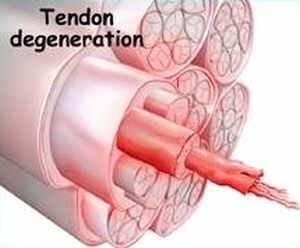

MedFriendly®


Angiofibroblastic degeneration
Angiofibroblastic degeneration is a condition that refers
to a type of degeneration within the substance of a
Degeneration means to deteriorate from a strong or
normal state to a weaker or abnormal state. So when a
tendon degenerates, it becomes weaker. Tendons are
made up of strands of fibers. When a tendon
degenerates, some of these strands get jumbled
together and some of the fibers break. These problems
with the fibers cause the tendon to get weaker.
FEATURED BOOK: Treat Your Own Achilles Tendinitis
In addition to damage to the fibers (hence the word "fibro" in "angiofibroblastic") there is
also decreased blood flow to the tendon in angiofibroblastic degeneration. Decreased
blood flow leads to further weakness of the tendon. Thus, angiofibroblastic degeneration
refers to a weakening of the tendons due to decreased blood flow and damage to the
fibers that make up the tendons. The end result is the formation of an abnormal type of
tissue in the tendon, known as angiofibroblastic tissue. All of the above-mentioned
changes to the tendon occur due to some type of overuse of the area of the body that
the tendon is in. Angiofibroblastic degeneration comes from the Greek word "angeion"
meaning "vessel," the Latin word "fibra" meaning "fiber," the Greek word "blastos"
meaning "germ," the Greek word "ikos" meaning "pertaining to," and the Latin word
"degenerare" meaning "to become unlike others." Put the words together and you have
"pertaining to vessels, fiber, germ, to become like others."
"Where Medical Information is Easy to Understand"™















